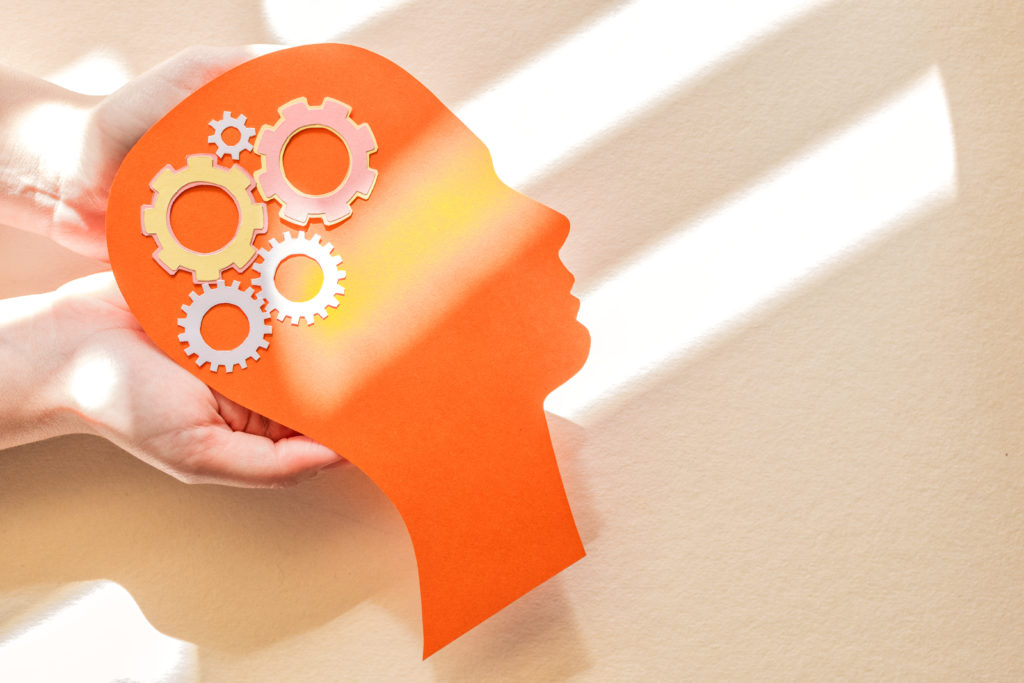The brain and the body are often viewed as separate, each with its own area of influence. Yet, when we take a closer look, we see they are brilliantly and wonderfully interconnected. The brain is not an isolated commander issuing orders. Instead, it is an integral part of the body’s intricate system. In this blog, we explore the connection and partnership between the brain and the body.
Why we think of them as separate
The idea that the brain and the body are separate has been planted in our culture and scientific understanding. We tend to focus on their individual contributions to health or disease. This mindset has been accepted as truth because it is easy to think of the brain and body as separate. But, by placing these systems into distinct boxes we fail to capture the complexity of their relationship. The body and the mind are an integrated system that allow us to move through life. Before we uncover the truth, let’s first recognize the ideas that have led us to create separation:
Perception of control
The brain’s command center role has led us to believe it holds dominion over the body’s functions. This idea of control reinforces the idea of separation. It positions the brain as the master conductor. The body then becomes the obedient and separate entity it controls. Every sensation and experience that feels like too much is placed in a box. This box then gets pushed away because anything unknown feels out of our control. More often than not, we lack the time and resources to understand the sensations of our body and what they mean. So, it becomes our default to bypass or ignore any experiences that feel overwhelming or out of our control.

Drug companies use our tendency to avoid uncomfortable sensations or experiences as their crutch. They provide medications that further numb our felt experience, whether emotionally or physically. For many, these medications feel like life savers. They allow individuals to feel a sense of control. But, they fail to provide the support we need to learn how to move through challenging experiences. Support is often hard to find and takes time and money that many can’t afford. In many ways, it is easier to continue functioning in a known and understood way. Yet, this limits our connection with our bodies as part of that learned experience.
Historical perspective
The Cartesian dualism propagated by philosopher René Descartes emphasized the mind-body divide. This separation has left a lasting legacy. It has shaped our understanding of health, illness, and the human experience. This legacy continues to be passed down today, and it’s easy to understand how it furthers our desire for control. Religion has also played a part in separating the body from the “soul” or mind. When philosophies and religions support an idea that feels right and comfortable, it becomes the belief. This can become an influence that creates a way of moving through life that isn’t always beneficial. Healthcare in the United States has been showing a steady decline in health. One of the contributing factors may be dissociation. We have become so removed from ourselves and our bodies that our ability to find care for ourselves has become limited. With this in mind, it makes sense why there has been a recent shift to focusing on self-care in modern times. We are beginning to recognize that our habits neglect a fundamental part of ourselves.
How the brain and body are connected
The intricate connection between the brain and body is orchestrated through the nervous system. The nervous system is a complex network of information highways. These highways relay information from all over the body to the brain and from the brain to the body. Let’s take a brief look at the essential elements of this system:

Central Nervous System (CNS): The CNS is made up of the brain and spinal cord. It gathers and processes information, and then generates responses to send back out. The brain serves as the command center, while the spinal cord acts as a relay system. This relay system transmits signals between the brain and peripheral nervous system. Signals are being received every moment of life. Some signals don’t even need to be received by the brain to generate a response. We are all born with reflexes such as the grasping, startle, and palmar reflexes. Muscle tone is also created by the CNS. This supports our posture and various other needs that would be too much for us to manage consciously.1
Peripheral Nervous System (PNS): The PNS is another extension of the nervous system that branches throughout the body. It connects sensory receptors to the brain and allows motor responses to be carried out. The PNS bridges the brain-body divide, enabling constant communication. The PNS reaches into the muscles of our body and our different organs. The communication between the body and the brain is bidirectional. This means the body can send information to the brain, and the brain can send messages to the body.1
Autonomic Nervous System (ANS): The ANS controls involuntary bodily functions. Involuntary functions are functions we don’t have to think much about, such as our heartbeat, digestion, and breathing. As the nerves of this system extend away from the CNS, they become classified as part of the PNS. It consists of two branches. One branch increases activation and readies the body for action. This branch is called the sympathetic nervous system. The other branch of the ANS slows us down and allows us to rest and digest. This branch is called the parasympathetic nervous system. These branches work together to respond to and perceive life events.1
Why we need the body’s information
The body is not a passive vessel. It influences the brain’s decisions and its behaviors. Our senses are windows to the world, providing crucial information for survival. The body’s sensory receptors send signals to the brain. These signals allow us to perceive and interact with our environment. This information is then interpreted through our brain’s filters to create meaning. Oftentimes, our brain’s filters include past experiences and cultural narratives. The body’s internal environment is a delicate balance that the brain monitors and regulates.

To maintain homeostasis, the brain relies on the body’s signals from our inner senses, called interoceptors. Interoceptors inform the brain of critical elements such as temperature and blood sugar levels. More recently, research has found that our body also stores emotional experiences. These experiences are held and add to our perception and interpretation of the external world. These experiences in our body are vital to creating a sense of “I am safe” or “I am not safe.” Our gut, which is often called the “second brain”, is a significant source of information.2 A specific nerve called the dorsal vagus nerve travels directly from the brain to the gut. Over 80% of the vagus’ nerve fibers carry information from the gut to the brain. These networks influence mood, behavior, and overall health and well-being.3
How the brain interprets our senses
The brain doesn’t passively receive sensory information. It is active in interpreting and making meaning out of the information it receives. This is a fine distinction but a critically important one to make. Our body is actively taking in information that is available to it through our external senses as well as our internal senses. Nerves from sensory organs then pass the information along to the brain. The brain then stores it and interprets it further.3
Perception and Context
Our context and past experiences influence our sensory experiences. As we learn about the world through experience, our brain creates connections. These connections influence, by default, how future experiences are perceived. We are more influenced when we are young, but it’s not just our brain creating these interpretations. Our body has a significant role in holding emotional imprints that are also part of what’s being interpreted.
For instance, the same sensation of a racing heartbeat can be interpreted as excitement or anxiety, depending on the context. The body is also experiencing events faster than our brain can make meaning from them. Imagine scoring the winning point in a competition. The first thing you experience after is not a thought of “I feel happy” or “I feel alive.” Instead, you most likely feel a sense of relief or exaltation in your chest. You might even raise your fists and feel a rush of adrenaline. The experience triggers a physical response, and our past experiences help us make meaning of it.1

How pain can be ignored or addressed promptly
Pain is a vital sensory signal that can either be ignored, to our detriment, or acknowledged for optimal health. Our brain is to be aware of both internal and external threats to our health. The brain is active in this process. It takes information from our nerves and relates the signal to previous experiences. The first brain area these messages pass through is an area to determine if there is a threat. Is this signal significant in any way? Every moment of life, the brain is searching for danger. Our beliefs have an active role in how we process our sensations. The more fear we have about a specific event, such as getting a splinter, the more our brain will connect that experience to a significant danger. As discovered in pain research, we now understand that pain is an experience created by the brain.
All pain is real, but our brain plays a significant role in interpreting pain signals. Part of this process is due to an area of the brain called the amygdala. A portion of the amygdala’s role is to analyze sensations and inform the rest of the brain whether it is “bad” or “good.” The amygdala holds our strong emotional memories to create these judgments of what we sense. The thought, “if I touch a piece of wood, a splinter of wood will get stuck in my hand, it will get infected, and I might die” is an example of the brain registering something as “bad” and therefore accepting it as true. Again, these beliefs are adaptations to life experience and feel entirely valid for the individual. Now, imagine if this person accidentally touched a piece of wood. There would be an emotional response to the fear caused by this belief. The amygdala will trigger an alarm that activates the threat response system. This increases vigilance and triggers a cascade of other responses that result in a heightened experience of pain or fear.4

Just as our brain can be trained to feel more pain, it can also be trained to feel less. While this ability can be helpful in specific scenarios, it can lead to injuries if pain signals are continually ignored. Pain is an essential system for us to survive and thrive. If we shut off our feelings or ignore pain-related sensations, we set ourselves up for increased risk of wear and tear. Over time, this can lead to degeneration and dysfunction that becomes complicated to treat. Pain is the guard that prompts us to take action before dysfunction occurs. The body is incredibly resilient, but we have to work with it to keep all its systems in balance.5
Pain is a broad category. Most will move through their day sitting at a desk feeling tension in their lower back, knees, hips, neck, and shoulders but not consider it painful. We each carry our own definition of pain, and we often create one far too tolerable to sensations that trigger our attention. Being aware of imbalance is the first step to taking action to correct it. If we change our definition of pain to include uncomfortable sensations, we become much more in tune with what we are experiencing. Ignoring pain can exacerbate underlying issues. Timely recognition and appropriate responses are crucial for injury prevention and recovery.
Understanding and awareness as the gateway to health
Understanding the connection between the brain and body invites us to cultivate awareness. By doing so, we open the door to holistic health. Let’s take a look at how awareness supports health and wellness:
Mind-Body Connection
Recognizing the interplay between the brain and the body can help develop our mind-body connection. This connection informs our decisions and responses. This may feel like some new age ideal or philosophy, but in reality it has been the subject of countless research studies. Research suggests the mind-body connection improves our mental, physical, emotional, and social well-being.

Body awareness and presence helps us develop behaviors, attitudes, and connections that support our sense of happiness. Body awareness also helps us heal and recover from injury. Lacking body awareness and presence can be harmful to our well-being. When we cut off parts of ourselves, our emotions, and sensations, we limit our ability to be adaptable and create meaning in our lives. To be open to the goodness of life, we need to be connected to it; we need to feel it.5
Pain Management
Acknowledging the connection between pain and the brain allows us to manage pain effectively. We have many opportunities to move, change our behaviors, and choose good things for us. The fear of the unknown or our stuck negative perception of life often traps us and limits our choice to one solution: to endure. Life is more than the big picture we get stuck on, though. When we are in tune to our pain and have compassion and empathy for ourselves, we are better able to support ourselves. When we recognize our many options, we are better able to manage our body’s pain and discomfort. Our body is incredible and can endure large amounts of stress. Yet, the more we can partner with it, the more we can support it in the process that it needs for healing to occur.
Pain isn’t just physical damage, either. Pain is when a signal is triggered in the body, sent to the brain, and interpreted through the lens of our experience. We can get stuck in the fear of what has happened or what will happen. But, by letting go of the thoughts and instead focusing on sensations, we can more accurately know what we are experiencing. It is like having a direct line to connecting with what is true and accurate instead of what’s imagined. Research shows that when we can calm the amygdala through mindfulness, there is often a reduction in pain. Mindfulness facilitates the body’s natural healing processes by creating a state of rest and recovery.2
Holistic well-being

Holistic health encompasses the mind, body, and spirit. Understanding the brain and body connection encourages us to focus on the wellness of our whole being. In our quest of understanding the human experience, we often draw lines to separate the brain and body. Yet, as we journey further, we uncover the truth. The brain and body are not separate entities but a singular symphony. The brain’s signals and the body’s responses are woven together in a tapestry of life that defies compartmentalization. Recognizing this intricate connection fosters a profound shift in how we approach health, well-being, and the art of living. By embracing the profound unity of the brain and body, we invite harmony, vitality, and a renewed sense of wholeness into our lives.
References
- Barsotti N, Chiera M, Lanaro D, Fioranelli M. Impact of stress, immunity, and signals from endocrine and nervous system on fascia. Frontiers in Bioscience-Elite. 2021;13(1):1. doi:https://doi.org/10.2741/870
- Ceunen E, Vlaeyen JWS, Van Diest I. On the Origin of Interoception. Frontiers in Psychology. 2016;7. doi:https://doi.org/10.3389/fpsyg.2016.00743
- Carvalho GB, Damasio A. Interoception and the origin of feelings: A new synthesis. BioEssays. 2021;43(6):2000261. doi:https://doi.org/10.1002/bies.202000261
- Fox AS, Oler JA, Tromp DPM, Fudge JL, Kalin NH. Extending the amygdala in theories of threat processing. Trends in neurosciences. 2015;38(5):319-329. doi:https://doi.org/10.1016/j.tins.2015.03.002
- Strigo IA, Craig AD (Bud). Interoception, homeostatic emotions and sympathovagal balance. Philosophical Transactions of the Royal Society B: Biological Sciences. 2016;371(1708):20160010. doi:https://doi.org/10.1098/rstb.2016.0010
